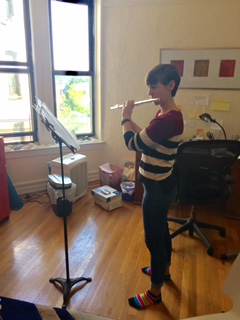Within the Karg-Elert op. 107 Studies, we focused on nos. 14 and 16. Articulation (read “French style tonguing”) was of course a key point with these two studies, but my biggest takeaway personally was the need to look ahead more in the music. This is something that’s very true for me overall, as I tend to fixate on each note/moment as it’s happening, rather than doing that while also anticipating what’s to come. Robert’s elegant method of executing this practice of looking ahead was to block off a measure at a time with his thumb while I was playing. It was effective, though admittedly somewhat clumsy on my part. Specifically with no. 14, we talked about the illusion of time and the practical ways we can manipulate its perception.
We reviewed Flying Lessons 3 once more, and Robert lent us disconnected lip plates to practice tongue stops with a mirror to make sure we’re getting the tongue position right to completely seal the hole. We started on Flying Lessons 4, going over a few techniques found there, such as the residual tone. To achieve a residual tone, one should roll the flute out enough that the back of the lip plate is more exposed while also “snarling” with the front lip to bring it up and over. It’s almost like the goal is to hit the back ridge of the tone hole with the air.
Other things:
- Robert has (and played) a nose flute; I had no idea that was a real thing
- Joe fixed my window! It was slightly open at the top, but now it is not. And it makes things SO MUCH QUIETER
- I went to see the band Re:Groove and they were kickin’
Until next time!

